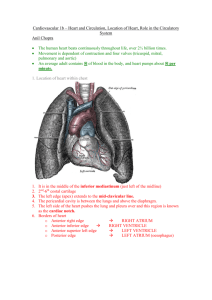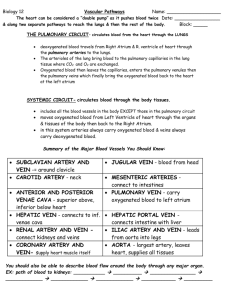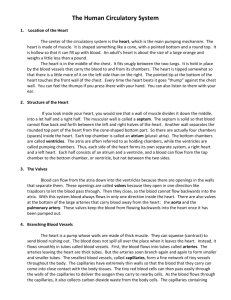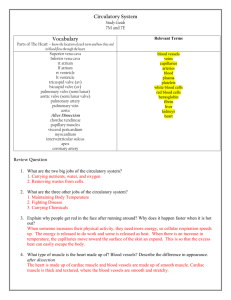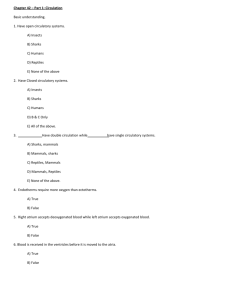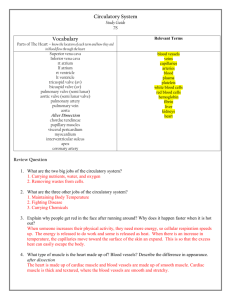Pupil Notes Unit 2 section 2 of 2
advertisement
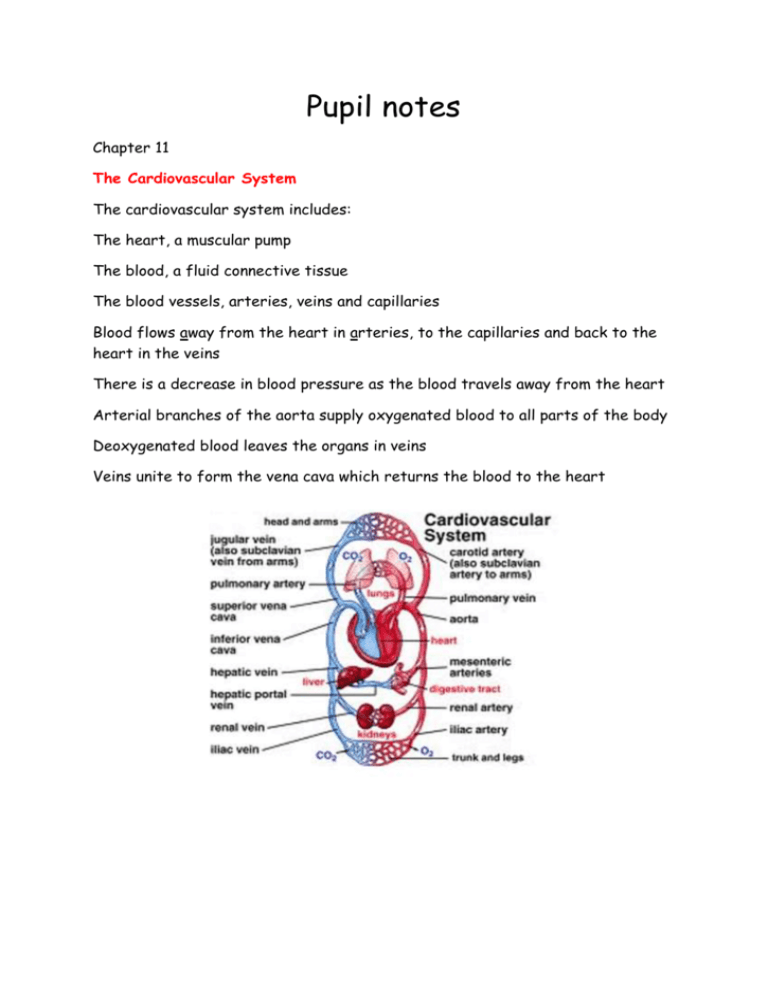
Pupil notes Chapter 11 The Cardiovascular System The cardiovascular system includes: The heart, a muscular pump The blood, a fluid connective tissue The blood vessels, arteries, veins and capillaries Blood flows away from the heart in arteries, to the capillaries and back to the heart in the veins There is a decrease in blood pressure as the blood travels away from the heart Arterial branches of the aorta supply oxygenated blood to all parts of the body Deoxygenated blood leaves the organs in veins Veins unite to form the vena cava which returns the blood to the heart Pulmonary System This is the route by which blood is circulated from the heart to the lungs and back to the heart again The pulmonary system is exceptional in that the pulmonary artery carries deoxygenated blood and the pulmonary vein carries oxygenated blood Hepatic Portal Vein There is another exception in the circulatory system – the hepatic portal vein Veins normally carry blood from an organ back to the heart The hepatic portal vein carries blood from the capillary bed of the intestine to the capillary bed of the liver As a result, the liver has three blood vessels associated with it Arteries and Veins The central cavity of a blood vessel is called the lumen The lumen is lined with a thin layer of cells called the endothelium The composition of the vessel wall surrounding the endothelium is different in arteries, veins and capillaries Arteries carry blood away from the heart Arteries have a thick middle layer of smooth muscle They have an inner and outer layer of elastic fibres Elastic fibres enable the artery wall to pulsate, stretch and recoil, thereby accommodating the surge of blood after each contraction of the heart Smooth muscle can contract or become relaxed This contraction or relaxation brings about vasodilation or vasoconstriction to control blood flow During strenuous exercise the arterioles leading to the muscles undergo vasodilation – the circular muscle in the arteriole wall is relaxed and the lumen is wide This allows an increased blood flow to the skeletal muscles At the same time, the arterioles leading to the small intestine undergo vasoconstriction The circular muscles are contracted and the lumen is narrow As a result, this reduces the blood flow to the gut Veins carry blood back to the heart The muscular layer and layers of elastic fibres in the vein wall are thinner than those in an artery because blood flows along a vein at low pressure The lumen of a vein is wider than that of an artery Valves are present in veins, to prevent the backflow of blood Following two slides compare an artery and vein Capillaries and Exchange of Materials Blood is transported from arterioles to venules by passing through a dense network of blood vessels called capillaries All exchanges of substances between blood and living tissue takes place through capillary walls Capillary walls are composed of endothelium and are only one cell thick Plasma is a watery yellow fluid containing dissolved substances such as glucose, amino acids, blood cells, platelets and plasma proteins Blood arriving at the arteriole end of a capillary bed is at a higher pressure than blood in the capillaries As blood is forced into the narrow capillaries, it undergoes pressure filtration and much of the plasma is squeezed out through the thin walls This liquid is called tissue fluid The only difference between plasma and tissue fluid is that plasma has proteins Tissue fluid contains a high concentration of dissolved food, oxygen, useful ions etc. These diffuse, down a concentration gradient, into the surrounding cells Carbon dioxide and other metabolic wastes diffuse out of the cells, down a concentration gradient, into the tissue fluid to be excreted Tissue fluid and Lymph Much of the tissue fluid returns to the blood in the capillaries at the venule end of the capillary bed This is brought about by osmosis Tissue fluid lacks plasma proteins so it has a higher water concentration than the blood plasma Some of the tissue fluid does not return to the blood in the capillaries This excess tissue fluid is absorbed by thin-walled lymphatic vessels When the tissue fluid is in the lymphatic vessel it is called lymph Tiny lymph vessels unite to form larger vessels Flow of lymph is brought about by the vessels being compressed when muscles contract during breathing, movement etc. Larger lymph vessels have valves to prevent backflow Lymph vessels return their contents to the blood via two lymphatic ducts These enter the veins coming from the arms Structure and Function of the Heart Continuous circulation of blood is maintained by a muscular pump, the heart The heart is divided into 4 chambers, two atria and two ventricles The right atrium receives deoxygenated blood from all parts of the body via the vena cavae Deoxygenated blood passes into the right ventricle before leaving the heart through the pulmonary artery The pulmonary artery divides into two branches, each leading to a lung Oxygenated blood returns to the heart by the pulmonary veins It flows from the left atrium to the left ventricle before leaving the heart by the aorta The wall of the left ventricle is more muscular and thicker than that of the right ventricle The left ventricle is required to pump blood all around the body The right ventricle only pumps blood to the lungs Valves between the atria and ventricles are the atrio-ventricular (AV) valves Valves prevent the backflow of blood The presence of valves ensures the blood flows in one direction through the heart Semi-lunar valves are present at the origins of the pulmonary artery and the aorta These valves open during ventricular contraction allowing flow into the arteries When arterial pressure exceeds ventricular pressure, they close Cardiac Function At each contraction the right ventricle pumps the same volume of blood through the pulmonary artery as the left ventricle pumps through the aorta Heart rate (pulse) This is the number of heart beats per minute Stroke volume This is the volume expelled by each ventricle on contraction Cardiac output is the volume of blood pumped out of a ventricle per minute It is summarised by the following equation – CO = HR X SV HR is heart rate, SV is stroke volume Pulse, health indicator If a person is fit, the quantity of cardiac muscle present in their heart wall is greater and more efficient than that of an unfit person A very fit person tends to have a lower pulse rate than an unfit person – the fit person’s heart is larger and stronger A fit person’s stoke volume is greater A fit person’s heart does not need to contract as often to pump an equal volume of blood round the body Chapter 12.


